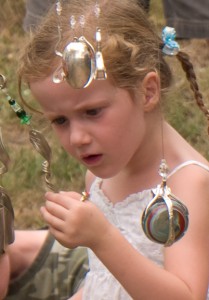 First of all, I’d like to introduce my newest audio program:
First of all, I’d like to introduce my newest audio program:
8 Steps to Connected Parenting
For those of you who want a quick, easy guide to some of the most important aspects of creating connection with your kids, I’ve recorded 8 Steps to Connected Parenting, my audio guide to Conscious Parenting 101. You can check out this audio program (only available in MP3 download) here: http://www.awakeparent.com/8steps/
Although this 45 min. audio program is easily worth $20, I’ve decided to offer it for just $8 because I’m hoping you’ll love it, find it very useful, and tell all your friends about AwakeParent.com.
To give you a taste of what this audio program is about, I’ll share one of the steps with you now…Step 5: Check in and Get Curious
Getting curious is one of the most effective ways to invite people to share their inner worlds with you. When we’re genuinely curious we ask interested questions and people (including children) are compelled to talk with us about what’s going on inside them.
One question to avoid when you want to start a dialogue is “why”. “Why” puts children into conceptual thought and doesn’t get to the heart of the matter. Now besides their initial problem, they’re being asked to figure out the reasons for their discomfort and that only leads to more anxiety and upset.
Instead of asking why, try asking questions about what happened, how she’s feeling, or what sensations she’s noticing in her body. Repeat back what she tells you and ask her to confirm that you’ve gotten it right. This reflection allows kids to correct you if you’re off track and lets them know that you’re really listening and understanding what they’re telling you.
After you’ve repeated and gotten confirmation that you’re hearing your child accurately, ask, “what else?” This phrase is an invitation for whatever else your child wants to share.
Here’s an example of a conversation between John and his mom who is curious and reflective.
M: “So John, how are you feeling?”
J: “I don’t know,” looks away.
M: “Are you feeling upset?”
J: “Yeah, I guess”
M: “So, you’re feeling pretty upset, huh?”
J: “Well, actually, I’m mad at Tom”
M: “Oh, you’re mad at Tom. Is that right?”
J: “Yeah.”
M: “What else?”
J: “Well, he said he’s not my friend anymore and that hurt my feelings.”
M: “Oh, so when Tom said he’s not your friend anymore, your feelings were hurt.”
J: “Yeah.”
At this point Mom might acknowledge John’s feelings, letting him know that it’s OK to feel what he feels and she’s glad he’s shared his inner world with her. This lets John know that his feelings matter and it’s OK to feel exactly what he does. He learns that his mom cares about him and is available to empathize with him. She may ask more questions about what happened with Tom, but she’s careful not to push John or to be overly invasive. She maintains her genuine curiosity throughout the exchange, but is able to let go when John is finished sharing.
 Sometimes it’s challenging to remain curious. For instance, if we already think we know what happened, we might assume a child is being deceptive if her story doesn’t match up with what we think we know. But if we can remain curious, and really try to understand her point of view, rather than asserting our own, we become a LOT more available for connection and kids naturally feel more safe, secure, and willing to share. Letting go of our assumptions is a huge key to getting in touch with genuine curiosity.
Sometimes it’s challenging to remain curious. For instance, if we already think we know what happened, we might assume a child is being deceptive if her story doesn’t match up with what we think we know. But if we can remain curious, and really try to understand her point of view, rather than asserting our own, we become a LOT more available for connection and kids naturally feel more safe, secure, and willing to share. Letting go of our assumptions is a huge key to getting in touch with genuine curiosity.
I’m super curious about your own experiences with checking in and getting curious and how it has created connection (or not) for you.
Please share some of your experiences, or ask follow up questions below. I read every single comment and try to respond to most of them. I really appreciate you being here and hope to see you here week after week.
Have a wonderful day, Shelly


This one is big for me. I get so rush rush rush that I hurry my kiddo through her stories and assume I know how they end. The other day I just listened and asked questions as you suggested here and I heard this very amazing story and it gave me some interesting perspective into her life and experience. I’d love some suggestions on how to slow down and listen especially when frustrated or in a hurry. 🙂
.-= Jackie´s last blog ..Garden Planning Preschool Style [Project] =-.
Hey Jackie, I’m glad to hear that my blog helped you! I love it that you were able to gain new insight into your daughter through really listening. Regarding slowing down and listening, my first thought is that breathing deeply has helped me to stop rushing and relax enough to really listen to kids. I think that rushing can be an addiction in our culture, so I’ve consciously created a life in which I have extra time built in so that I don’t need to rush so much. I may start to get ready 20 minutes earlier just so that I can relax and enjoy my getting ready time.
Regarding frustration, I’d recommend that you tune in to what has you feeling frustrated and maybe take a moment to offer yourself some listening and empathy. My guess is that you’re needing efficiency or cooperation in the moments when you feel frustrated, but it could be something completely different. Perhaps you need to call a friend for support or hit a pillow or do something else to release the frustrated energy. Then, when you’ve taken care of yourself, you’ll have much more space to listen to you daughter and it won’t even feel like work!
Thanks so much for your comment Jackie! I hope this helps 🙂 Hugs, Shelly
Thanks for your reply! It is definitely the need for efficiency and mostly cooperation, you hit it on the head. Great reminder to deal with myself before I try to deal with her. 🙂 Thanks!!
.-= Jackie´s last blog ..Are You Having an “If You Give a Cat a Cupcake” Day? =-.